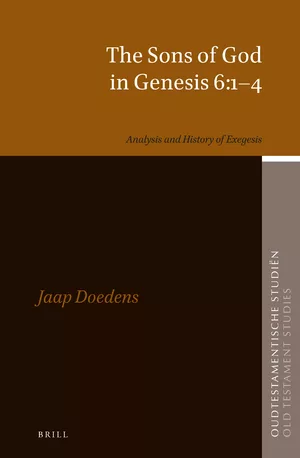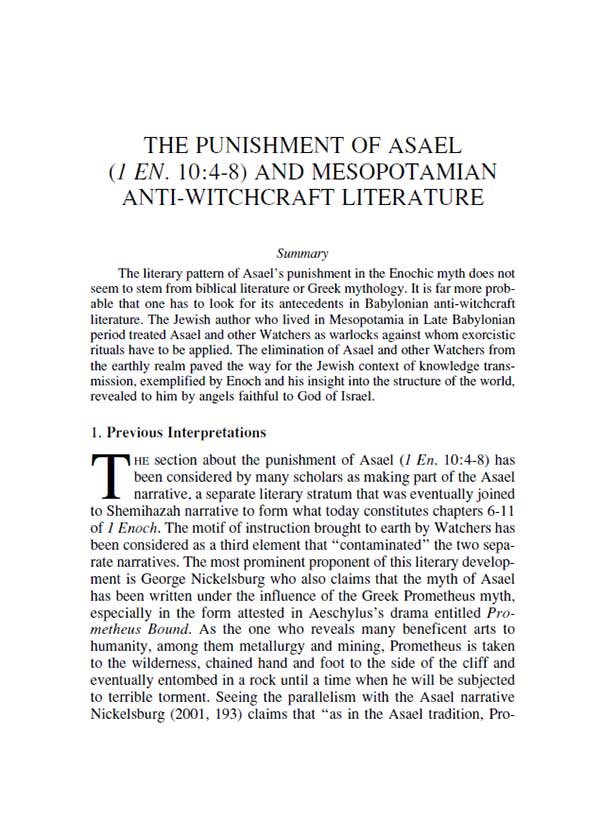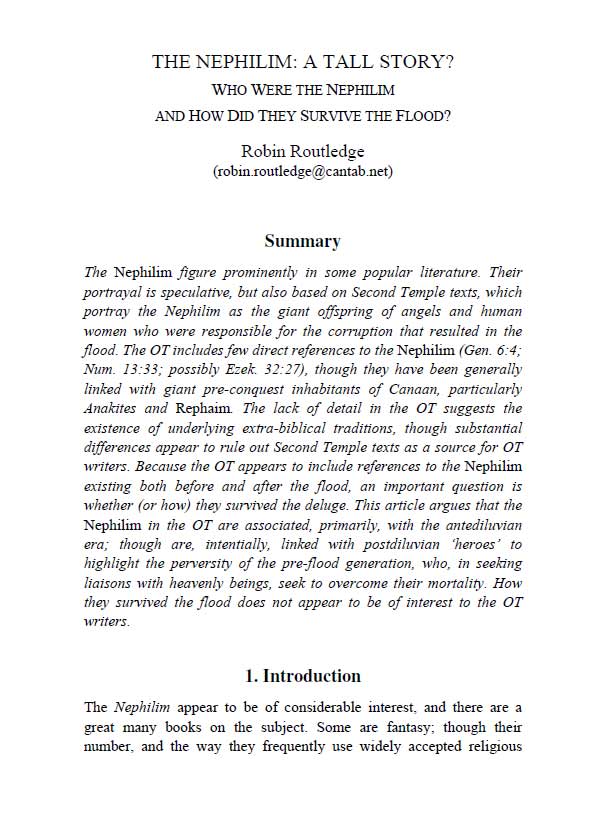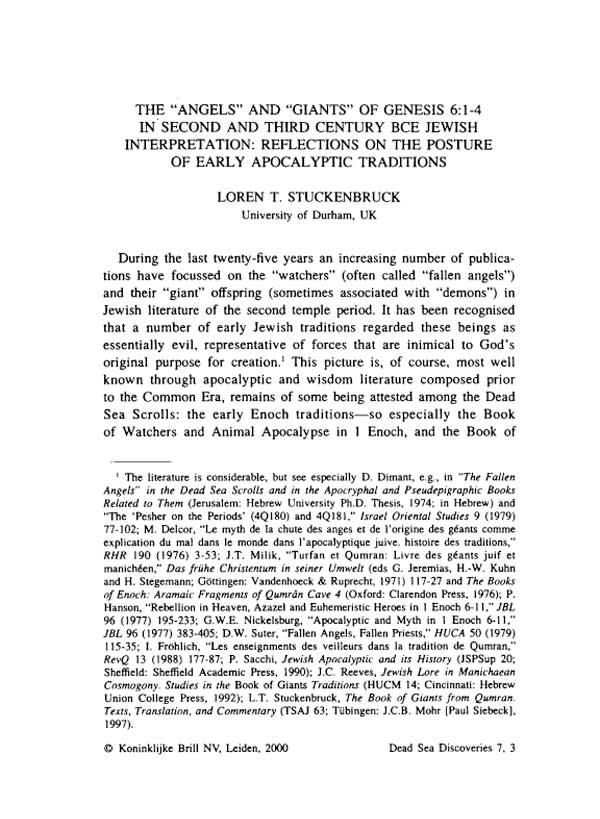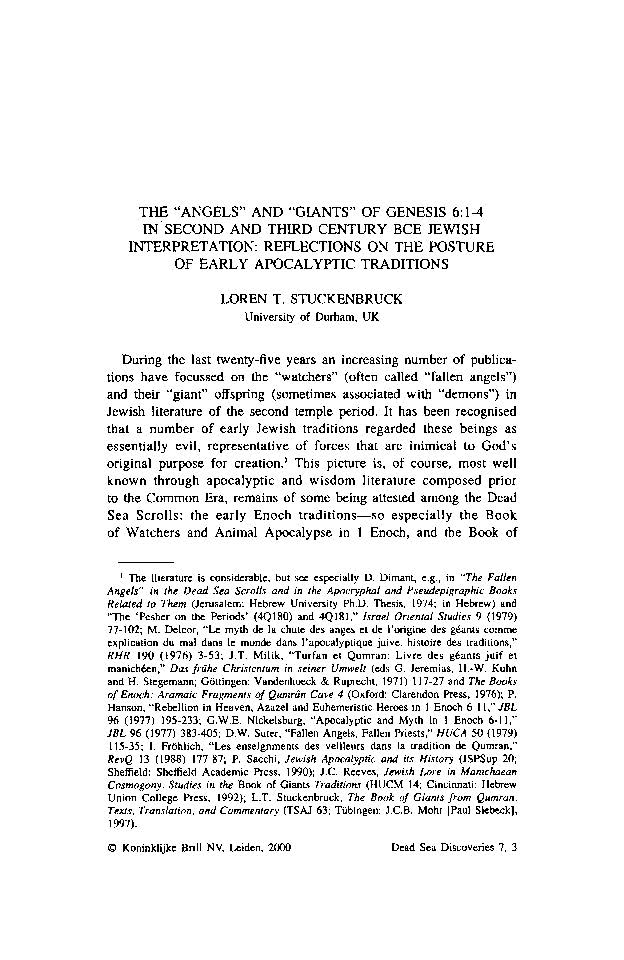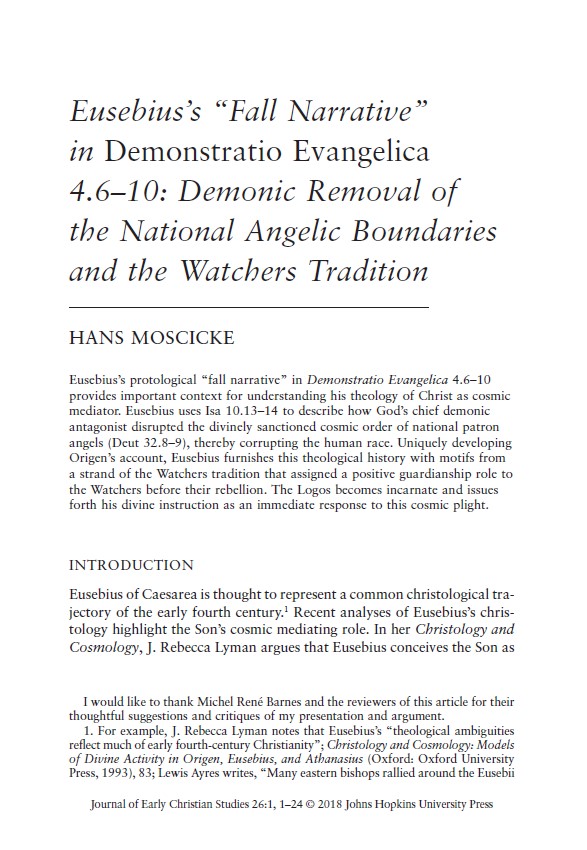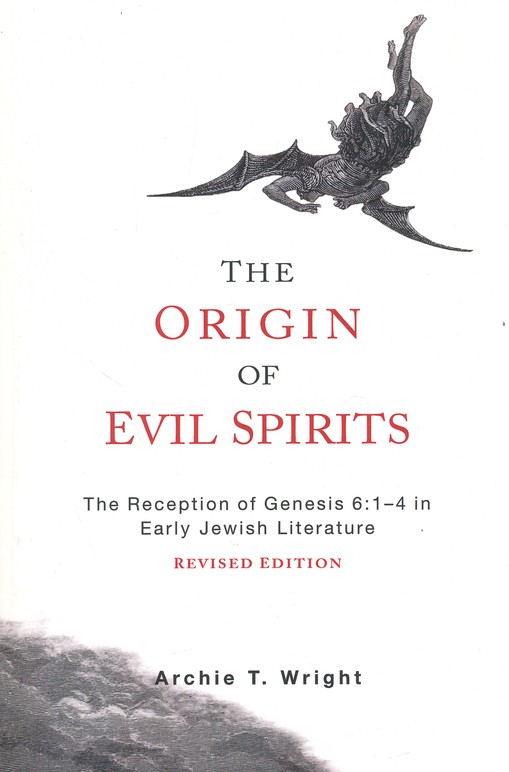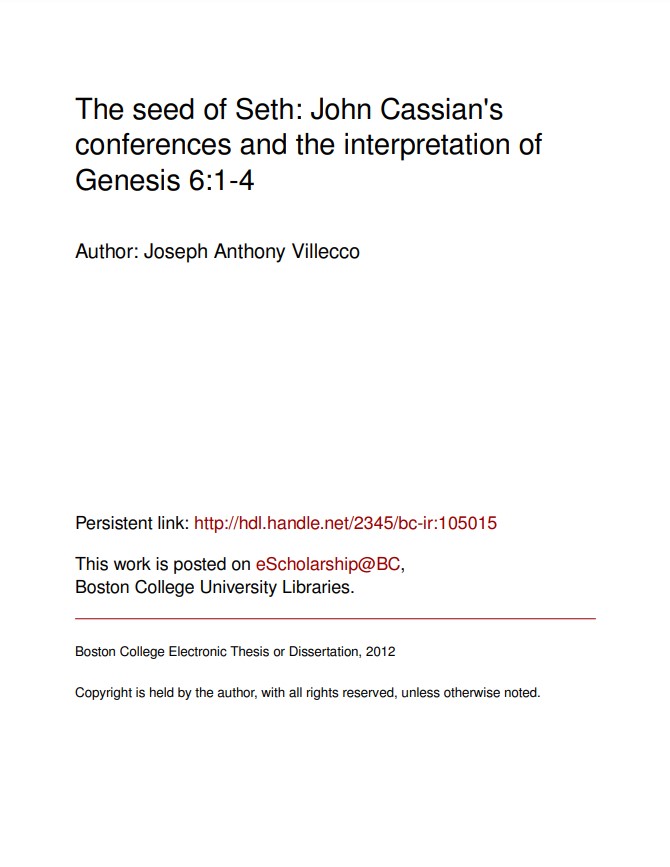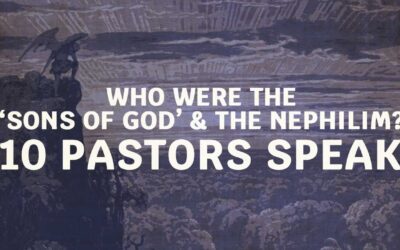Explore RESEARCH
A database of modern research papers related to the story of the Nephilim and ‘sons of God’ in Genesis 6.
The Sons of God in Genesis 6:1–4
J.J.T. Doedens – College associate professor at the Pápa Reformed Theological Seminary, Hungary | 2019
Researcher Jaap Doedens provides an outline of the history of interpretation of the cryptic text regarding the “sons of God,” “daughters of mankind,” and “giants.”
One of the most comprehensive and wide-reaching scholarly approaches to this subject.
This book is quite expensive on Brill.com.
However, Mr. Doeden’s dissertation on the subject (2013) is available to read online. As well Mr. Doedens has an article summarizing his findings here.
Excerpt
The use of the expression ‘sons of God’ in Gen 6:1–4 appears to be similar to identical expressions in other Old Testament texts. Evidence from comparison of these passages indicates that the expression functions as a set phrase, always referring to unspecified divine beings.
Is the “Sons of God” Passage in Genesis 6 Adapted Pagan Mythology?
Lee Anderson, Jr. – Answers Research Journal | 2015
This study thoroughly analyzes the interpretations of conservative biblical scholars of “the sons of God” in Genesis 6, while focusing on showing that this passage is not the result of pagan concepts prevalent at the time.
As well, this study urges Christians to appreciate the merits of the many positions—positions that, while often very different, are unified in their purpose of attempting to understand Genesis 6:1-4.
Excerpt
All the views evaluated in this paper (at least in the versions presented) are resistant to the notion of Genesis 6 being adapted myth. They make no room for Scripture’s alleged acquiescence to the prevailing pagan ideas of its day. Although this study finds the fallen angels view to be the view most consistent with the biblical data, Bible-believing advocates of all the interpretations of Genesis 6:1–4 can appreciate the strengths of the different positions—positions which, though often vastly different, are united in their goal of striving to see the trustworthiness of Scripture upheld.
On the Origin of Watchers: A Comparative Study of the Antediluvian Wisdom in Mesopotamian and Jewish Traditions
Amar Annus – Journal for The Study of The Pseudepigrapha | 2010
Amar Annus (University of Tartu, Estonia) argues that the Enochian ‘Watchers’ are derived from the ‘apkallus’ – antediluvian sages in Mesopotamian mythology.
Excerpt
The ‘sons of God’ in Genesis and the Watchers in Enochic literature are fully divine, as also were the antediluvian apkallus in the Mesopotamian tradition.
The four post-flood apkallus were ‘of human descent’, which means that apkallus could mate with humans, as the Watchers did.
The last one of this group of apkallus, Lu-Nanna, was only ‘two-thirds apkallu’ (Kilmer 1987: 39-40). This exactly matches the status of Gilgamesh in the post-diluvian world, as he also was ‘twothirds divine, and one-third human’ (I 48).
Gilgamesh was remotely related to antediluvian apkallus, as he ‘brought back a message from the antediluvian age’ (I 8). In Jewish terms, he was like one of the giant Nephilim, as exactly the Book of Giants depicts him (Stuckenbruck 2003: 329).
There is new supporting cuneiform evidence that Gilgamesh was thought of as having a gigantic stature, his height being 11 cubits (George 2007: 240 l. 34).
The “Angels” and “Giants” of Genesis 6:1-4 in Second and Third Century BCE Jewish Interpretation
Loren T. Stuckenbruck – Ludwig-Maximilians-Universität München Faculty Member | 2000
Looking at the environment and debates regarding antediluvian evil that plays out in 2nd Century Jewish apocalyptic literature such as the Book of Enoch, Jubilees, Baruch, Damascus Document, etc.
Taken from Dead Sea Discoveries, Vol. 7
Excerpt
During the last twenty-five years an increasing number of publications have focussed on the “watchers” (often called “fallen angels”) and their “giant” offspring (sometimes associated with “demons”) in Jewish literature of the second temple period. It has been recognised that a number of early Jewish traditions regarded these beings as essentially evil, representative of forces that are inimical to God’s original purpose for creation…
However, unless these materials are considered in relation to a broader context of post-biblical interpretation and early Jewish adaptations of classical traditions from antiquity, it is impossible to appreciate their position within what appears to have been a debate among Jews during the third through first centuries BCE concerning the origins of culture and the origin of pre-diluvian evil…
In order to achieve this aim, I shall first briefly discuss the biblical texts, and then proceed to describe the role of “giants” in some of the euhemeristic sources, followed by a discussion of apocalyptic traditions which may in some measure be understood as a response to these sources…
Eusebius’s “Fall Narrative”: Demonic Removal of Angelic National Boundaries and the Watchers Tradition
Hans M Moscicke – PhD Candidate at Marquette University | 2018
Looking at how Eusebius views the fall and Christ as ‘cosmic mediator’, research Hans Moscicke looks at how threads of the traditional Enochian Watcher story are drawn from in the Christology of Eusebius.
Excerpt
Thus, the story of the fallen angels in its earliest form already associates the spirits of the Watchers’ offspring with the patron angels/deities. This connection becomes more explicit in Jubilees.
In the second-century B.C.E. text Jubilees, the story of the fallen angels generally follows that of the Book of Watchers. Yet a key difference is that the Watchers are explicitly given a positive role of authority over humankind before their fall.
—-
Christ’s teaching and moral exemplarism were no mere tertiary qualities of the incarnate Logos. They were a divine response to the tangible threat of forces hostile to God in the world.
It is noteworthy that still in the early fourth century C.E., Jewish apocalyptic currents such as the Enochic Watchers myth and the patron angel tradition played an influential role in the theology of a “mainstream” Christian theologian. Scholars need to remain aware of and continue investigating the endurance of such Jewish traditions in the fourth century and their influence on the theologies and christologies of that era.
“Who are the Sons of God? A Literary-Contextual Approach to Gen. 6:1-4”
Dustin Mace
A research paper that analyzes the competing interpretations of the identity of the ‘sons of God’ and concludes that the ‘Sethite’ view is the best interpretation.
Excerpt
Gen 6:1 – 4 at once shows how the once-godly sons of Seth corrupted themselves (through the indiscriminate taking of wives, following ―no marriage law but their own lusts)and sets forth the patriarch Noah as the last faithful son of Seth remaining on earth.
The Origins of Evil Spirits: The Reception of Genesis 6:1-4 in Early Jewish Literature, Revised Edition
Archie T. Wright – Catholic Biblical Association | 2015
The work of Archie T. Wright traces the evolution of the notion of demonic spirits from the Hebrew Bible through postbiblical Jewish literature.
Wright is interested in the reception history of Genesis 6:1-4 (the basis of the “Watchers” legends) during the Second Temple Period in early Enochic and Philonic Judaism.
He claims that the nonspecificity of the biblical language of Genesis 6:1-4 laid the groundwork for the subsequent creation of an etiology of evil spirits when Jewish authors dealt with the text.
The seed of Seth: John Cassian’s conferences and the interpretation of Genesis 6:1-4
Joseph Anthony Villecco – Thesis for the School of Theology and Ministry, Boston College | 2012
This thesis examines the context behind a shift in interpretation happening in the church, as more and more the ‘Sethite’ identity for the ‘sons of God’ was replacing the traditional ‘Angel’ view.
Mr. Villecco gives us a window in the world of John Cassian and the influences behind his stance.
Excerpt
Genesis 6:1-4 has a complex interpretative history in Christianity. The passage details the apparent sexual union of the sons of God/angels of God and human women and the production of a monstrous offspring (the Nephilim), resulting in the corruption of the earth and leading to the flood. In the first centuries of Christianity, the tendency was towards a literal interpretation of the narrative, however, by the fourth century a notable shift emerged in orthodox Christian churches. The tendency arose to interpret the passage in a “demythologized” manner, seeing the sons of God as symbolic for the sons of Seth who began to intermarry with the descendents of Cain. Cassian follows the new line of interpretive thought, interpreting the sons of God as the “seed of Seth.”
DIG DEEPER
Explore further with respected Biblical scholars and thinkers.
10 POPULAR Pastors & SCHOLARS on the Nephilim and ‘Sons of God’ in Genesis 6
What do popular figures in Christendom like John MacArthur, Al Molher and others believe about the 'sons of God' in Genesis 6? Find out here! In this article, we break down the views of 10 modern conservative Bible commentators and pastors on the mysterious Nephilim...
John Piper’s Ministry tackles the Divine Council & the ‘Sons of God’
Kaspars Ozolins - a research associate at Tyndale House in Old Testament and the Ancient Near East - writes for John Piper's website a fairly detailed look at the concept of the "divine council" in his article for Desiring God. In "The Divine Council," Ozolins tackles...
Insights from Pastor Jeff Gill of Calvary Chapel
Pastor Jeff Gill from Calvary Chapel shares his insights into the ‘sons of God’ and Nephilim.

